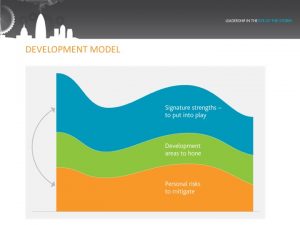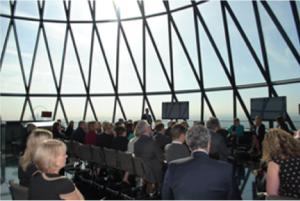Leadership in the eye of the storm
Developing leadership as a practice, in the white water and from the river bank
When the Northern Rock crisis hit, the Financial Services Authority (FSA) was immediately drawn into the eye of the growing financial storm. The pressure on its leadership team to make vital decisions – and to justify them in public – was intense. But just at that moment, many of the FSA’s current and potential leaders were also involved in an intensive executive development programme (EDP). Head of Organisation Development, Kelly Shortland, who was in charge of delivering the programme, immediately rang CEO Hector Sants to see if she should put it on hold. “Kelly,” he replied, “we’ve never needed it more.”
Early in 2007, the FSA’s executive board realised it needed to boost its overall leadership bench strength, if it was to cope with the challenges of the evolving regulatory landscape.
“We realised that we would need people who are effective all round leaders, rather than technical experts,” said Lesley Titcomb, COO. “People who can cope with change, people who can cope with pressure. We also need to act as a role model to the firms we regulate, so that we don’t ask of them what we don’t expect from ourselves.”
Engaging us as its leadership assessment and development specialists, the FSA developed an EDP that would help it create a cohesive group of leaders, who would work together to take the organisation through a complex period of change.
Asked if the programme should be put on hold, Sants replied “we’ve never needed it more.”
“A programme such as the FSA’s EDP allows leaders to reflect on their abilities and take stock of the situation,” says Mike Vessey. “We believe that leaders are not only forged in the white water of daily experience, but equally from the reflective space of the riverbank.”
In our work with some of the UK’s top organisations, we have identified what we believe are the seven key hallmarks of great leadership development, which:
- Work “inside-out” as well as “outside-in”, creating a climate for self-discovery, dialogue and reflection, as well as the opportunity for active experimentation, practice and evaluation.
- Keep it real, enabling participants to learn from working with real world challenges.
- Illuminate the “dark side”, helping individuals understand what might be holding them back and how to handle themselves when the going gets tough.
- Enable leaders to “join the dots”, making links between their own sense of purpose, set of skills and spikes of strength, and what the organisation really needs today and in the future.
- Value the participants’ resources, inviting them to bring their knowledge, experience, connections and understanding of the organisation, and to use them to give feedback to each other.
- Create powerful coalitions, connecting cadres of future leaders who believe the future of the organisation is in their hands.
- Appear on CVs: people not only angle for invites but once they’ve taken part, wear it like a badge of honour.
 “We wanted to design the programme around the participants,” explains Kelly Shortland. Because the FSA had recently overhauled its recruitment process to include far more rigorous assessment, it was possible to reposition the EDP and make it much more developmental. “It’s designed to make it a positive experience for the participants, something that was really engaging and not just ‘done to’ them.”
“We wanted to design the programme around the participants,” explains Kelly Shortland. Because the FSA had recently overhauled its recruitment process to include far more rigorous assessment, it was possible to reposition the EDP and make it much more developmental. “It’s designed to make it a positive experience for the participants, something that was really engaging and not just ‘done to’ them.”
Participants work on a live strategic challenge “a bit like the Apprentice” but the tasks are real
Each programme begins by gathering as much knowledge as possible about the participants as individuals. While the organisers have access to existing material, such as 360-degree performance reviews and psychometric tests, a key part of the EDP is a preparatory three-hour interview with each participant, covering their current role, personal and career history and aspirations. Gill Green, head of the FSA’s programme management group, says that being taken back to some of her most formative experiences was a “unique and challenging process”.
“The interview is really in depth. It goes back over your whole career,” she says. “That level of introspection and reflective analysis was really quite beneficial.”
The core of the EDP is a series of group activities, designed to test and develop the participants’ leadership skills. Shortland describes the process as being “a bit like the Apprentice” in the way that it elucidates participants’ behaviour but with a key difference: the tasks are real.
“We wanted it to be as realistic as possible, to feel like a day in the office,” says Shortland. “They turn up in the morning and are faced with a current live business challenge, such as the recruitment and retention of talent during a time of change, and get together as a group to work on it. All the activities we use in the programme are based on real-life challenging issues, not theoretical case studies, and the outcomes of the day are used to take them forward.”
By working on real-life issues and being under pressure to deliver results, the participants “join the dots” and make connections between their own capabilities and what the organisation needs.

360-degree panoramic views from the top of the Gherkin provided a stunning backdrop
“Because they are real-life scenarios, you have to understand what the organisation does as a whole. That’s something that is often overlooked in organisations that have so many specialisations,” says Gill Green, a recent participant. “It really forces you to have a wider understanding.”
To make the day more stimulating, the group sessions are kept short and are broken up with peer review sessions, where the participants feed back their perceptions of each other.
“The participants themselves are a resource on the programme and we need to maximise that and encourage them to deploy their own skills,” says Shortland.
“Being assessed by peer groups is slightly daunting and you know it’s going to be really competitive,” says Green. “But being assessed on how you deal with a real-life scenario means you have to change and reflect on your behaviour, and you also need to display those behaviours in how you interact with people.”
At the end of the EDP, each participant receives developmental feedback, which highlights their strongest points as well as those areas which need to be developed.
“We take a strengths-based approach because we really want people to harness and leverage these to achieve change,” says Shortland.
 But our model goes beyond simple strengths-based approaches to look at the “dark side” or shadow – those personal risk factors that are so often the flipside of people’s best qualities.
But our model goes beyond simple strengths-based approaches to look at the “dark side” or shadow – those personal risk factors that are so often the flipside of people’s best qualities.
“We try to play to people’s strengths but also to recognise the dangers if you overdo it,” says Shortland. “For example, we’ve typically recruited those who wanted to challenge the status quo and ruffle feathers but the question is how far you go in challenging people before you start to alienate them.” In between the areas of innate strength and personal risk, there’s the more traditional development zone that, with practice, people can address and make improvements.

Kelly Shortland, Head of Organisation Development, addressed 45 leaders
A key part of the programme is to develop individuals as leaders and to create a cohesive leadership group, who collectively believe they hold the future of the organisation in their hands.
“It’s not only helped me to be a coach and a mentor, but has given me the confidence to use the wider network of leaders,” says Green.
By following up the programme with feedback discussions involving line managers, the EDP is tied back into the FSA’s wider performance management process.
“It has longevity throughout your career,” said Green. “Your perception of yourself changes, you become more focused on the future and have more confidence to take your career forward.”
Shortland said that the programme was already delivering benefits:
“People who do well in the programme also have good 360-degree feedback scores, good ratings in staff satisfaction surveys and also good retention scores, which provides additional evidence,” she said. “Our employee engagement scores are in the high 80s, which is very good in a time of change.”
The FSA will shortly split into two successor bodies and will be expected to deliver ever more rigorous and challenging regulation, to protect consumers in what continues to be a tough and turbulent climate.
 “In times of crisis, decision-making gets dragged up the organisation,” says Lesley Titcomb. “You have to make sure that the senior people involved in those decisions are equipped to make them, while still doing all the other things that are expected of them.”
“In times of crisis, decision-making gets dragged up the organisation,” says Lesley Titcomb. “You have to make sure that the senior people involved in those decisions are equipped to make them, while still doing all the other things that are expected of them.”
For more information please contact: Mike Vessey

